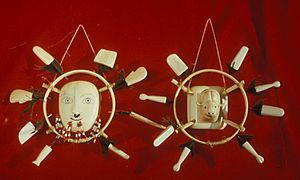Masks among Eskimo peoples facts for kids
Masks made by Indigenous peoples of the Arctic, often called Eskimo peoples, were used for many different reasons. These masks were crafted from materials found in nature, like driftwood, animal skins, bones, and feathers. They were often painted with bright, eye-catching colors. Scientists have even found tiny masks made of walrus ivory from very old times, like the early Paleo-Eskimo and Dorset cultures.
The term "Eskimo" is sometimes used to describe various Indigenous groups in the Arctic. However, in places like Canada and Greenland, many people prefer the term "Inuit" because "Eskimo" can be seen as offensive. But for Alaska Natives of Yupik and Iñupiat heritage, and Siberian Yupik peoples, "Eskimo" is still commonly used and preferred as a way to talk about all these groups together. These groups live across a huge area, from Siberia, through Alaska and Northern Canada, all the way to Greenland. Even though they share some things, their cultures, beliefs, and even languages can be quite different.
Ancient Masks and Their Uses
Scientists have discovered very old masks from early Arctic cultures, such as the Paleo-Eskimo and Dorset periods. People believe these ancient masks had several important uses. They might have been part of rituals where they represented animals in a special, human-like way. Shamans, who were like spiritual leaders or medicine people (sometimes called angakkuq), also used masks in ceremonies. These ceremonies often involved spirits, like a wooden mask found in southwestern Alaska suggests. It's also thought that some masks were worn during singing contests or special gatherings.
Beliefs Connected to Masks
Many Arctic peoples had deep beliefs about the connection between humans and animals. They didn't think humans and animals were exactly the same, but they believed there was a strong link. They had complex ideas about the soul, thinking that living people, their ancestors, and the animals they hunted were all connected. They also had stories about a time long ago when animals could change into human form whenever they wanted.
Special masks called transformation masks showed this idea of unity. During ceremonies, people would use these masks to act out these ancient stories. Sometimes, the person wearing the mask would even seem to become the animal spirit they were representing.
Yup'ik Masks
The Yup'ik people live in western Alaska and are known for their incredibly creative masks. Yup'ik masks come in all sizes. Some are tiny, like forehead or finger masks, while others are so big that dancers need help to wear them during performances. Many of these masks were like props in a play, and some were believed to give the dancer the spirit of what the mask represented. Often, these masks were destroyed after they were used in a ceremony. Other masks showed animal people (called yuit), insects, berries, plants, ice, and even everyday objects.
See also



